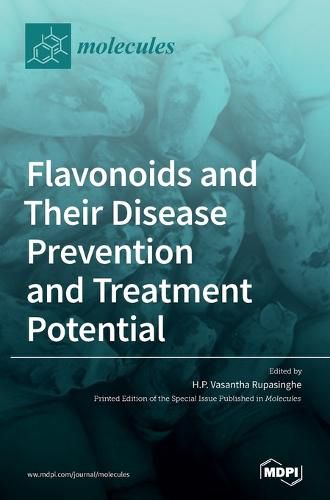Readings Newsletter
Become a Readings Member to make your shopping experience even easier.
Sign in or sign up for free!
You’re not far away from qualifying for FREE standard shipping within Australia
You’ve qualified for FREE standard shipping within Australia
The cart is loading…






This title is printed to order. This book may have been self-published. If so, we cannot guarantee the quality of the content. In the main most books will have gone through the editing process however some may not. We therefore suggest that you be aware of this before ordering this book. If in doubt check either the author or publisher’s details as we are unable to accept any returns unless they are faulty. Please contact us if you have any questions.
Flavonoids are ubiquitously present in plant-based foods and natural health products. The molecule of flavonoids is characterized by a 15-carbon skeleton of C6-C3-C6, with the different structural configuration of subclasses. The major subclasses of flavonoids with health-promotional properties are the flavanols or catechins (e.g., epigallocatechin 3-gallate from green tea), the flavones (e.g., apigenin from celery), the flavonols (e.g., quercetin glycosides from apples, berries, and onion), the flavanones (e.g., naringenin from citrus), the anthocyanins (e.g., cyanidin-3-O-glucoside from berries), and the isoflavones (e.g., genistein from soya beans). Scientific evidence has strongly shown that regular intake of dietary flavonoids in efficacious amounts reduces the risk of oxidative stress- and chronic inflammation-mediated pathogenesis of human diseases such as cardiovascular disease, certain cancers, and neurological disorders. The physiological benefits of dietary flavonoids have been demonstrated to be due to multiple mechanisms of action, including regulating redox homeostasis, epigenetic regulations, activation of survival genes and signaling pathways, regulation of mitochondrial function and bioenergetics, and modulation of inflammation response. The role of flavonoids on gut microbiota and the impact of microbial metabolites of flavonoids on optimal health has begun to unravel. The complex physiological modulations of flavonoid molecules are due to their structural diversity. However, some flavonoids are not absorbed well, and their bioavailability could be enhanced through structural modifications and applications of nanotechnology, such as encapsulation. This Special Issue consists of four review articles on flavonoids and 15 original research articles, which cover the latest findings on the role of dietary flavonoids and their derivatives in disease prevention and treatment.
$9.00 standard shipping within Australia
FREE standard shipping within Australia for orders over $100.00
Express & International shipping calculated at checkout
This title is printed to order. This book may have been self-published. If so, we cannot guarantee the quality of the content. In the main most books will have gone through the editing process however some may not. We therefore suggest that you be aware of this before ordering this book. If in doubt check either the author or publisher’s details as we are unable to accept any returns unless they are faulty. Please contact us if you have any questions.
Flavonoids are ubiquitously present in plant-based foods and natural health products. The molecule of flavonoids is characterized by a 15-carbon skeleton of C6-C3-C6, with the different structural configuration of subclasses. The major subclasses of flavonoids with health-promotional properties are the flavanols or catechins (e.g., epigallocatechin 3-gallate from green tea), the flavones (e.g., apigenin from celery), the flavonols (e.g., quercetin glycosides from apples, berries, and onion), the flavanones (e.g., naringenin from citrus), the anthocyanins (e.g., cyanidin-3-O-glucoside from berries), and the isoflavones (e.g., genistein from soya beans). Scientific evidence has strongly shown that regular intake of dietary flavonoids in efficacious amounts reduces the risk of oxidative stress- and chronic inflammation-mediated pathogenesis of human diseases such as cardiovascular disease, certain cancers, and neurological disorders. The physiological benefits of dietary flavonoids have been demonstrated to be due to multiple mechanisms of action, including regulating redox homeostasis, epigenetic regulations, activation of survival genes and signaling pathways, regulation of mitochondrial function and bioenergetics, and modulation of inflammation response. The role of flavonoids on gut microbiota and the impact of microbial metabolites of flavonoids on optimal health has begun to unravel. The complex physiological modulations of flavonoid molecules are due to their structural diversity. However, some flavonoids are not absorbed well, and their bioavailability could be enhanced through structural modifications and applications of nanotechnology, such as encapsulation. This Special Issue consists of four review articles on flavonoids and 15 original research articles, which cover the latest findings on the role of dietary flavonoids and their derivatives in disease prevention and treatment.